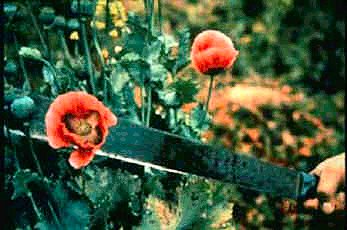Friday, November 19, 2004
Poppy's Revenge

The Afghan heroin Poppy is making a modest return to the dark corners of the selectively infotaining US media, this morning, with the New York Times, among a very few others, reporting news that’s, unless you are a major radio personality, kind of a downer:
Poppy cultivation in Afghanistan…was up sharply this year, reaching the highest levels in the country's history…More than 321,236 acres of land were planted with poppy in 2004, a 64 percent increase over last year, the United Nations survey found. Poppy has spread to every province in the country, it said. It was only by chance that drought and disease ravaged much of the crop and prevented the harvest from exceeding the all-time high, the report said. The harvest in 2004 was estimated at 4,200 metric tons, an increase of 17 percent from last year.
The web site of the Community Anti-Drug Coalitions of America, yesterday, published frightening information that has become tragically obvious, though no less covered by our local press, to families here in red state Kentucky concerning heroin’s increasingly rural distribution.
The CADCA republished this week’s Fax from the Maryland Center for Substance Abuse Research:
Heroin prices are lower in New York City…than in the non-metropolitan areas of the mid-Hudson region ($10 vs. $20-$25 per bag). Due to this price disparity, heroin dependent users from the suburbs travel to New York City to buy cheap heroin, then return to the suburbs to sell it at a higher rate to defray the cost of their habits. These dependent street dealers are known as “jugglers”… Jugglers also recruit new users—and thus promote heroin diffusion—by tricking them into using heroin, most often by misrepresenting it as cocaine.
The Narcosphere reports on a public hearing held yesterday in Boston, Massachusetts:
The Boston Public Health Commission's substance abuse services testified that addiction rates of certain drugs, especially heroin, are increasing, with a large fraction of the abusers being young people under 25 years old…Due to recent budget cuts, the number of spots available in drug recovery programs has gone from almost 1000 in 2001 to closer to 400 beds today, said the director of the substance abuse services: "Now, if someone who comes in to our offices wanting to deal with their addiction, but doesn't have health insurance, they are not guaranteed a bed in a recovery center.
The Narcosphere report also, interestingly, stated:
Federal financial and investigative branches are unwilling to prosecute banks and seize drug money accounts, even though they know which banks and accounts are involved in laundering, and are allowed by law to seize such accounts.
Photo: Google Images

